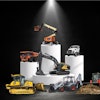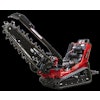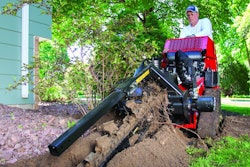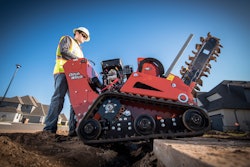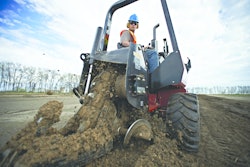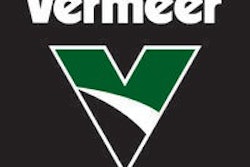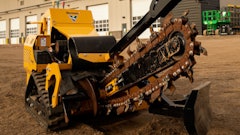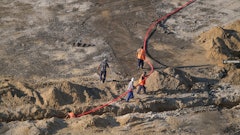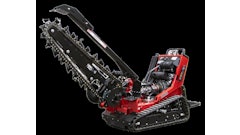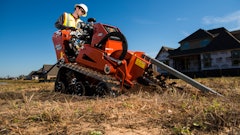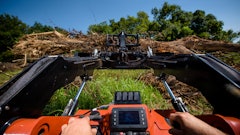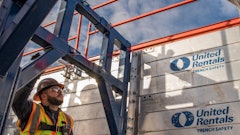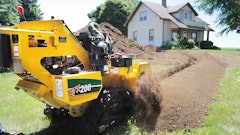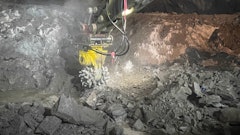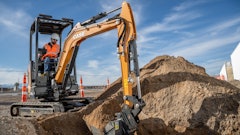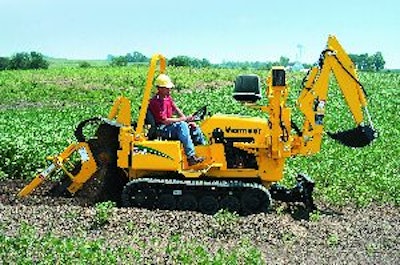
When it comes to trenching alternatives, there are 18-hp walk-behind (pedestrian) units that can dig a 4-ft.-deep by 6-in.-wide trench, and there are 120-hp ride-on units that can accomplish the same task. So which should you choose for your current job?
If you select a machine that's too small, you will sacrifice efficiency and could, in all likelihood, extend time on the jobsite beyond what is necessary. "Plus, it's harder on the user and the machine," says Tim Phelps, product manager, Barreto Mfg. "For example, if you're in rocks, the machine will want to hop around more. It's harder on the user because he has to do more of the work vs. the machine doing the job. Those vibrations are also hard on the machine."
Yet, if you choose a trencher that's oversized for the task, you could end up spending too much. "It's not a one size fits all market," says Greg Adkins, trench product manager, the Ditch Witch organization. "There are a variety of horsepower ranges and boom and chain options. It would be great if one worked for everyone, but Mother Nature doesn't work that way. We've had to come up with a number of ways to defeat her."
Evaluate ground conditions
When sizing a trencher, first evaluate the specifics of the job, i.e., how deep, how wide and how far the trench needs to be. That will easily narrow the field to a short list of a few models.
Next, evaluate ground conditions. "Learning about ground conditions is very important," says Bob Wren, Astec Underground. "It's probably more important than anything."
Ground conditions greatly affect productivity and the ability to efficiently move through the soil. "There's a big difference between doing a job in rock vs. one with good fill dirt," says Phelps. "If you're trenching in silty loam at 12 to 18 in. deep, I would recommend a smaller machine. It will be easier to handle, it will fit into tighter spaces and it will be less expensive to own and operate. On the other hand, if you're doing electrical lines 36 in. deep in tough conditions such as rock, clay or gumbo, you will need to consider something else."
A larger, higher horsepower machine gives you the ability to handle those difficult conditions more easily, because more horsepower means more torque to your digging chain, notes Jon Kuyers, utility product segment manager, Vermeer. This, in turn, gives you the ability to dig through difficult soil conditions such as caliche, sand, cobble and even rock.
"Generally, when you have more horsepower, you also have more weight," Kuyers adds. "All the components are larger and they're able to withstand more abuse and more difficult situations. The extra weight of the tractor also keeps the trencher boom in the ground and prevents it from bouncing around."
You may find that you have to oversize the trencher in certain ground conditions. ?Cobble and sand are very challenging applications,? says Adkins. ?You may need to dig deeper or wider than planned to accommodate carryover, which could necessitate the need for a larger machine.?
Do you need tracks?
Surface conditions also factor into the selection process. More manufacturers are offering units with rubber tracks. The benefits are two-fold: extra flotation to stay afloat in muddy conditions, and extra traction to pull through tough conditions.
With tires, there are only small points in contact with the ground. "You only have a few square feet on the ground at any one time," says Adkins. "With a track machine, you have considerably more, so the ground pressure is less and the machine will minimize turf damage."
The extra rubber on the ground also enhances performance. "If you can't pull the trencher through the ground and you're just spinning on tires, you're losing production," says Kuyers. "Tracks provide more traction when the ground is less than desirable. They're becoming more and more of a request.
"We've also noticed an increase in performance," he adds, "because the machine doesn't bounce as much as one on tires. That has increased production."
Utilize local experts
While understanding ground conditions is critical, it can be difficult given the fact they can vary dramatically, sometimes within little more than an hour's drive. "Tulsa is just an hour and 20 minutes from our office," says Adkins, "and the ground conditions are totally different."
That becomes important if you're working in an area where the soil conditions are unfamiliar. "What works well in one part of the country might not work well in another," Adkins points out. "And it's not necessarily that the machine can't handle it, but they have the wrong tool on the chain."
"A contractor in Fargo, ND, in nice 'potato dirt' can likely get by with a 40-hp machine," Kuyers comments. "But that same machine would have a more difficult time in San Antonio, TX, 'rock' ground where conditions are more difficult."
To ensure a better match, Adkins encourages utilizing the expertise of the local dealer/distributor, which is staffed by locals who know the area.
"Talk to your dealer. They are the local expert who can direct you to the best machine for a given application," agrees Kuyers. "We [manufacturers] can talk specs and provide good guidelines, but all 50 states are different. A local dealer knows the local ground conditions. Utilize that knowledge. It's something that's free."
Walk-behind or ride-on?
The selection process will likely include discussions about walk-behind vs. ride-on units. Walk-behind units are a popular choice for smaller, short-run jobs, such as residential irrigation where trenches are cut relatively shallow. These models are also typically less than 36 in. wide, so they can maneuver through backyard gates.
"You may be working in tight areas, such as a zero lot line home where you're trying to get into the backyard to replace existing infrastructure," Kuyers says. "You need a small machine because you can't physically fit a large one. You will have to trench slower, but you may have no other option."
Walk-behind units are generally self contained. "A plumber, for example, might have a smaller walk-behind unit... because he will have other tools he needs to carry to a jobsite," says Adkins. "Also, cutting a trench from the house to the curb is one of many tasks he will do. He might only utilize the trencher for a small portion of his day when he's out doing a job, so the need for a dedicated ride-on is not there."
Ride-on units are a good fit when trenching is a day-in, day-out task. "It's a lot nicer to operate because you?re sitting down," says Kuyers. "It's less work. Generally, with a ride-on, there's a backfill blade on the front of the machine so once you open up the trench, you have something to close it with.
"In my opinion, any time you move deeper than 36 in. and cut any wider than 6 in., you're better off with a ride-on trencher," he continues. "The amount of spoils a walk-behind trencher can handle is limited. The ride-ons have more robust systems with more horsepower, so they can pull more dirt out of the trench. And they're built heavier for more difficult soils."
Ride-ons also weigh more, which can be an advantage in difficult conditions. "You want a tractor that's built heavy-duty to withstand a lot of abuse that a trencher goes through," says Kuyers. "Imagine pulling up rocks. The chain is catching on those rocks and you can see the machine bouncing up and down. The larger the trencher, the more work can be done and the more abuse it can handle."
They are also a better choice for longer distance trenching jobs, such as commercial irrigation for a multi-family unit. "You're still burying at a shallow depth, but you're going long distances," says Wren. "The bigger the machine, the faster you can go and the more productive you can be.
"A consumer putting in his own irrigation lines can rent a small walk-behind unit and take his time putting it in. But a contractor wants to do it as fast as he can," he adds. "Evaluating application is important. You can dig a 10-mile trench with a 40-hp tractor, but you will be there all year. That's when it becomes important to pick the right tractor for the job, then outfit it to the ground conditions you will dig in."
In the end, ask yourself what situations you will be in 70% to 80% of the time, suggests Kuyers. "That's what you should base your decision on," he says. "Don't try to get by with something that is too small. Even though it may be able to do the job, it takes too long and you wear out the machine. But don't buy a huge piece of equipment if you don't need it, because you won't be able to utilize it as much."

